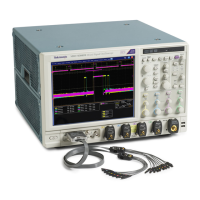Commands Listed in Alphabetical Order
Syntax
CURSor:MODe {T
RACk|INDependent}
CURSor:MODe?
Arguments
TRACk ties the navigational functionality of the two cursors together. For cursor 1
adjustments, this ties the movement of the two cursors together; however, cursor 2
continues to move independently of cursor 1.
INDependent allows independent adjustment of the two cursors.
Examples
CURSOR:MODE TRACK specifies that the cursor positions move in unison.
CURSOR:MODE? might return :CURSOR:MODE TRACK, indicating that the two
cursors move in unison.
CURSor:SCREEN:STYle
This command sets or queries the cursor type for Screen mode.
Group
Cursor
Syntax
CURSor:SCREEN:STYle {LINE_X|LINES|X }
CURSor:SCREEN:STYle?
Arguments
LINE_X specifies the cur
sor style to be a line with superimposed X.
LINES specifies the cursor style to be a line.
X specifies the cursor style to be an X.
Examples
CURSOR:SCREEN:STYLE LINES sets the cursor style to lines.
CURSOR:SCREEN:STYLE? might return :CURSOR:S CREEN:STYLE X, indicating
that the style for screen cursors is X.
CURSor:SCREEN:XPOSITION<x>
This command sets or queries the x position of the specified screen cursor. The
cursor is specified by x, which can be 1 or 2. If the cursor is not specified, it
defaults to cursor 1.
Group
Cursor
DPO7000, DPO70000/B and DSA7000/B Series Programmer Manual 2-135

